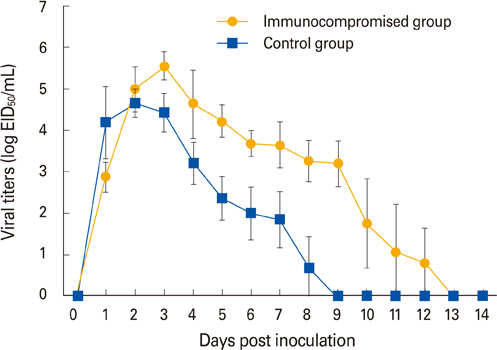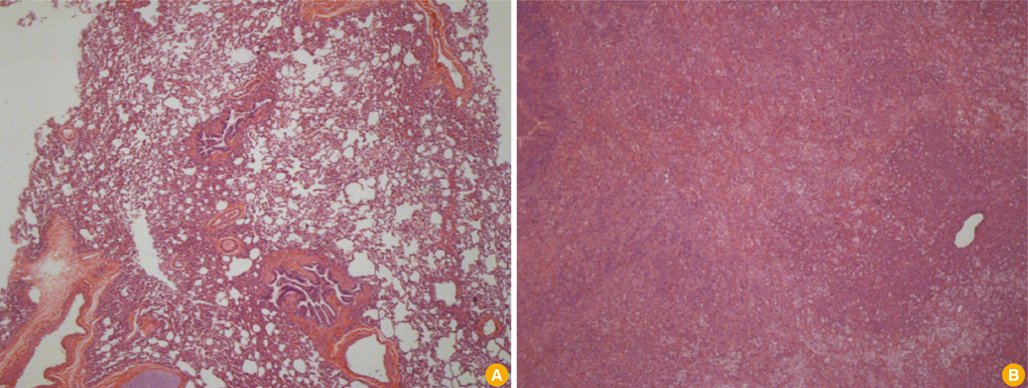Clin Exp Vaccine Res.
2013 Jan;2(1):66-68.
Prolonged shedding of the canine influenza H3N2 virus in nasal swabs of experimentally immunocompromised dogs
- Affiliations
-
- 1Viral Infectious Disease Research Center, Korea Research Institute of Bioscience and Biotechnology, Daejeon, Korea. sds1@kribb.re.kr
- 2University of Science and Technology, Daejeon, Korea.
- 3Research Unit, Green Cross Veterinary Products, Yongin, Korea.
- 4National Veterinary Research and Quarantine Service, Anyang, Korea.
- 5Bionote Inc., Suwon, Korea.
- 6College of Pharmacy, Korea University, Sejong, Korea.
Abstract
- PURPOSE
The avian origin canine influenza virus H3N2 has been recently isolated and found to be currently in dog population in South Korea and China. The purpose of this study was to clarify the relationship between immunosuppressive glucocorticoids used in veterinary clinical practice and viral shedding pattern of influenza in dogs.
MATERIALS AND METHODS
Eight conventional beagle dogs were divided into control infection group and immunocompromised group. Dogs of both groups were infected with H3N2 canine influenza virus (2x106.0 EID50/0.1 mL). Dogs in immunocompromised group were given orally 3.0 mg/kg prednisolone for 7 days. Virus shedding was monitored using real-time polymerase chain reaction. After necropsy, histopathologic lesions were compared.
RESULTS
We found that immunocompromised dogs exhibited more prolonged (8 days vs. 13 days) and higher magnitude viral shedding than control group (peak titer of viral shedding 4.6 vs. 5.5 EID50).
CONCLUSION
Restricted use of immunosuppressive drugs in the clinical setting might help control the rapid spread of H3N2 through local dog populations.
MeSH Terms
Figure
Reference
-
1. Wright PF, Webster RG. Knipe DM, Howley PM, editors. Orthomyxoviruses. Fields virology. 2001. Philadelphia: Lippincott William & Wilkins;1533–1579.2. Lee C, Song D, Kang B, et al. A serological survey of avian origin canine H3N2 influenza virus in dogs in Korea. Vet Microbiol. 2009. 137:359–362.
Article3. Payungporn S, Crawford PC, Kouo TS, et al. Influenza A virus (H3N8) in dogs with respiratory disease, Florida. Emerg Infect Dis. 2008. 14:902–908.
Article4. Song D, Kang B, Lee C, et al. Transmission of avian influenza virus (H3N2) to dogs. Emerg Infect Dis. 2008. 14:741–746.
Article5. Viviano KR. A practical approach to immunosuppressive therapies. AAHA/OVMA Toronto 2011 Proceedings. 2011. 2011 Mar 24-27; Toronto. Lakewood: American Animal Hospital Association.6. Ledbetter EC, Kim SG, Dubovi EJ, Bicalho RC. Experimental reactivation of latent canine herpesvirus-1 and induction of recurrent ocular disease in adult dogs. Vet Microbiol. 2009. 138:98–105.
Article7. Giannella M, Alonso M, Garcia de, et al. Prolonged viral shedding in pandemic influenza A(H1N1): clinical significance and viral load analysis in hospitalized patients. Clin Microbiol Infect. 2011. 17:1160–1165.
Article8. Lee N, Chan PK, Hui DS, et al. Viral loads and duration of viral shedding in adult patients hospitalized with influenza. J Infect Dis. 2009. 200:492–500.
Article9. Pinsky BA, Mix S, Rowe J, Ikemoto S, Baron EJ. Long-term shedding of influenza A virus in stool of immunocompromised child. Emerg Infect Dis. 2010. 16:1165–1167.
Article10. Bowen RA, Rouge MM, Siger L, et al. Pathogenesis of West Nile virus infection in dogs treated with glucocorticoids. Am J Trop Med Hyg. 2006. 74:670–673.
Article
- Full Text Links
- Actions
-
Cited
- CITED
-
- Close
- Share
- Similar articles
-
- Seroprevalence of three influenza A viruses (H1N1, H3N2, and H3N8) in pet dogs presented to a veterinary hospital in Ohio
- Influenza virus vaccine for neglected hosts: horses and dogs
- Experimental infection of dogs with highly pathogenic avian influenza virus (H5N8)
- Evolution and international transmission of H3N2 canine influenza A viruses from Korea during 2014–2017
- Detection of canine respiratory coronavirus from dogs with respiratory disease



